 |
|
Mapping out the history of Argentina (foto: Robles Pepe) |
Think you know what turned Argentina from an early 20
th
-century success story into a Wall Street pariah? Economic mismanagement? Culture? A Latin American boom-bust cycle on steroids?
Try geography.
In the recently released book,
In the Land of Silver: 200 Years of Argentine Political-Economic Development
(CreateSpace Independent Publishing Platform), Walter Molano, chief economist at BCP Securities and an adjunct professor at Columbia University, offers an intriguing reading of the financial history of this nation of immigrants. In it, Molano details the arc of the Argentine economyfrom the countrys early days as a Spanish colony to its emergence in the early 1900s as an industrial and agricultural powerhouse to its massive debt default in 2001through the lens of geopolitics.
Regional animosities in the country, he asserts, started early on. In Argentina’s colonial days, the port city of Buenos Aires flourished as a tollbooth, serving as an entrepot for legal and illegal goods, including agricultural products from the countryside and minerals from the distant Andes Mountains. Thus, a codependent and often rocky relationship between the capital and the provinces was born.
Molano’s telling of Argentina’s development as a nationand an economic powermakes for compelling reading. Indeed, he offers a detailed account of how this geographic fissure, along with a string of strong leaders seeking to transform a nation dependent on external factors Argentina’s financial fortunes. “The geographic and political characteristics of Argentina have been permanent features since its inception,” Molano writes. “Therefore, the fact that the country enjoyed an unprecedented era of prosperity at the start of the twentieth century was due to external factors rather than internal decisions.”
Molano, a US Naval Academy graduate, argues that the upheavals in the country during the latter half of the 20th century were due to a sharp deterioration in the terms of trade rather than bad policy choices. The gyrations, he asserts, were made worse by Argentina’s individualistic forms of government and the country’s heavy reliance on natural resources, which “accentuated the amplitude of the business cycles.” This, he argues, “had nothing to do with who colonized Argentina or what nationalities immigrated there.”
Admittedly, economic mismanagement and a tendency to devolve into chaos and military intervention are part of Argentina’s political and economic DNA. But the influence of geography is often overlooked by those with a vested interest in the country, from overseas investors to policymakers at home. Adam Smith, after all, did point out that alongside labor and capital, land plays a major role in productivityor the lack thereof.
That tension is still playing out in Argentina in the 21
st
century. Buenos Aires’s fiscal relationship with its provinces, for instance, stymied government efforts to negotiate a way out of the debt crisis in 2001. The failure to put together an agreement with creditors was a disaster, occurring exactly when demand for the country’s agricultural goods was set to boom with China’s entry into the World Trade Organization. Those exports could have revived the country. Instead, the economy crumbled and output plummeted, with GDP in 2002 coming it at a dismal -10.9%.
Molano’s research is thorough, which makes the book a must-have for students of Argentine history, as well as emerging markets investors. The book also illustrates the need for economists and investors to pay close attention to history, a liberal art just like economics. History isnt mutually exclusive from the so-called dismal science. Rather, it serves as the source from which economics springs forth. Although some readers might have enjoyed seeing quotes sprinkled in from sources who contributed to the book (including former Argentine economy ministers Roberto Lavagna and Ricardo Lopez Murphy), Molano’s work is an accurate and freshly unique take on Argentina, then and now.



